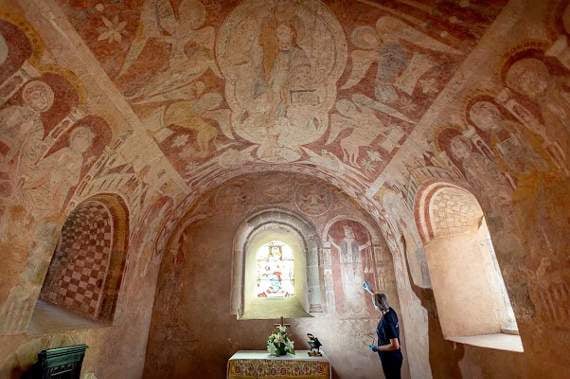AN APPEAL has been launched to ensure the future of some of the most important mediaeval wall paintings in Europe – at a tiny Forest church.
The paintings at Kempley Church near Newent date back to the 12th century and are the most complete Romanesque wall decorations in northern Europe.
They were whitewashed over in the 1550s as part of King Edward VI’s drive to replace Catholicism as the religion of England.
They were uncovered in the last century, but attempts at restoration may have put their long-term future at risk.
English Heritage has now launched an appeal to conserve wall paintings at locations across the country, including Kempley.
The charity says £20 can pay for specialist mortar to replace plaster damage, £40 can pay for the consolidation of powdering and flaking surfaces and £75 can pay for expert ‘multi-spectral’ imaging revealing details of a painting’s conditions that would otherwise be invisible to the human eye.
At Kempley, conser- vators are particularly keen to assess the effects of a material which was used in the 20th century restoration.
It is feared it could be doing damage to the surface of the paint, said senior conservator Rachel Turnbull in a podcast about the project available on the English Heritage website.
She said: “Possibly there is a material at Kempley which is causing minute degradation to the surface of the paint.
“One of the first things we would like to do at Kempley is an assessment of how ubiquitous the use of this material is and whether it is possible to remove it.”
English Heritage say the highly-skilled conservation comes at a cost and is calling on people to support the appeal, by visiting. www.english-heritage.org.uk/wallpaintings
Ms Turnbull said: “If they are to survive for future generations to enjoy, we need the public’s help today to repair the buildings, stabilise their structures and protect them from damp and decay before time runs out.
“Wall paintings are the most challenging type of art to care for, but they offer a precious insight into England’s story.”
The whitewashing of the paintings at Kempley actually had the effect of preserving them, said senior property historian Stephen Brindle.
He said: “The paintings at Kempley were done in the 12th century and some in the 14th.
“They were whitewashed over in the 16th and uncovered in the 20th.
“The Reformation was hostile to images – there was an Act for the defacing of images passed by Edward VI in 1550 and all over England, religious schemes of art were whitewashed over.
“Painting over had the effect of preserving them.”
The other sites that are part of the five-year project range from a Roman villa in Kent to Victorian gothic revival architecture in Yorkshire.




Comments
This article has no comments yet. Be the first to leave a comment.